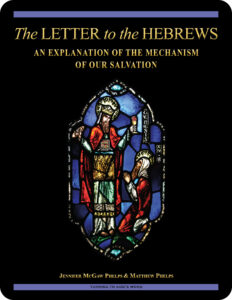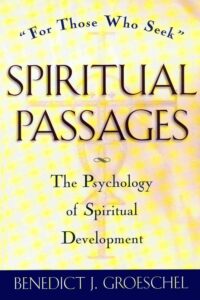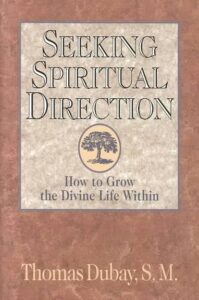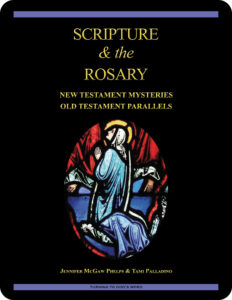 The Letter to the Hebrews:
The Letter to the Hebrews:
An Explanation of the Mechanism
of Our Salvation
Lesson 8 A Better Hope Is Introduced
the Letter to the Hebrews 7:18–28
Revised Standard Version Catholic Edition (RSVCE)*
New American Bible Revised Edition (NABRE)*
Catechism of the Catholic Church
Rosarium Virginis Mariae (Rosary of the Virgin Mary)
ex libris (in our library)
Tami Palladino’s visual-meditation journal
cross references in the Letter to the Hebrews
next lesson: Enacted on Better Promises
This material coordinates with Lesson 8 on pages 29–31 in The Letter to the Hebrews: An Explanation of the Mechanism of Our Salvation.
“In the days of his flesh, Jesus offered up prayers and supplications with loud cries and tears, to him who was able to save him from death, and he was heard for his godly fear. Although he was a Son, he learned obedience through what he suffered; and being made perfect he became the source of eternal salvation to all who obey him, being designated by God a high priest according to the order of Melchizedek.”—the Letter to the Hebrews 5:7–10
welcome to our in-depth study of the Letter to the Hebrews
We invite you to check out the sample first lesson and video from this 18-lesson  Turning to God’s Word Catholic Bible study. Our online study pages link to free
Turning to God’s Word Catholic Bible study. Our online study pages link to free  lesson videos and cross references in the biblical text, and include illustrations and prayers based on Scripture in each lesson. The Letter to the Hebrews: An Explanation of the Mechanism of Our Salvation has been granted an imprimatur. It currently being expanded; the content will be available in a new printed study at a later date. Please contact us if you’re interested in purchasing a digital copy of the existing study.
lesson videos and cross references in the biblical text, and include illustrations and prayers based on Scripture in each lesson. The Letter to the Hebrews: An Explanation of the Mechanism of Our Salvation has been granted an imprimatur. It currently being expanded; the content will be available in a new printed study at a later date. Please contact us if you’re interested in purchasing a digital copy of the existing study.
open with prayer
It’s always wise to begin any Bible study with prayer, whether reading the Scriptures alone or meeting with others in a discussion study group. You can pray using your own words or use one of the opening prayers on our website. We especially like the following:
Lord Jesus, you promised to send your Holy Spirit
to teach us all things.
As we read and study your word today,
allow it to touch our hearts and change our lives. Amen.
strong & not very flattering words about the law
 The author of the Letter to the Hebrews doesn’t mince his words when writing about the source of hope offered to God’s people prior to Christianity, referring to Old Testament law as something weak and useless. Why do you suppose it is that he apparently thinks he needs to use such forceful language and insists on talking about things on the one hand and on the other hand? Don’t miss Tami Palladino’s illustrated reflections on the Scripture passages that form the basis of The Letter to the Hebrews: An Explanation of the Mechanism of Our Salvation. Click on the illustration (left) to enlarge it, and also check out Turning to God’s Word founder Tami’s visual-meditation journal to see all of her drawings and meditations. Tami’s reflections for this lesson, “A Better Hope Is Introduced,” are on pages 30 through 33 of her journal.
The author of the Letter to the Hebrews doesn’t mince his words when writing about the source of hope offered to God’s people prior to Christianity, referring to Old Testament law as something weak and useless. Why do you suppose it is that he apparently thinks he needs to use such forceful language and insists on talking about things on the one hand and on the other hand? Don’t miss Tami Palladino’s illustrated reflections on the Scripture passages that form the basis of The Letter to the Hebrews: An Explanation of the Mechanism of Our Salvation. Click on the illustration (left) to enlarge it, and also check out Turning to God’s Word founder Tami’s visual-meditation journal to see all of her drawings and meditations. Tami’s reflections for this lesson, “A Better Hope Is Introduced,” are on pages 30 through 33 of her journal.
 every lesson has a free video (06:40)
every lesson has a free video (06:40)
Don’t forget—each lesson of The Letter to the Hebrews: An Explanation of the Mechanism of Our Salvation  has a related video. In these short presentations, Turning to God’s Word author Matthew Phelps reads the biblical text for the lesson and comments about it. You can watch the videos as part of your preparation for group discussion or to catch up if you have to miss a discussion. Some groups watch the videos together prior to their discussions. Because the videos are on YouTube, you can access them wherever and whenever it’s convenient—and they’re free. This study and its
has a related video. In these short presentations, Turning to God’s Word author Matthew Phelps reads the biblical text for the lesson and comments about it. You can watch the videos as part of your preparation for group discussion or to catch up if you have to miss a discussion. Some groups watch the videos together prior to their discussions. Because the videos are on YouTube, you can access them wherever and whenever it’s convenient—and they’re free. This study and its  videos are undergoing revision to incorporate additional material. The original content will be included in a different printed study. The original 18 lessons pertaining to the Letter to the Hebrews currently are available digitally.
videos are undergoing revision to incorporate additional material. The original content will be included in a different printed study. The original 18 lessons pertaining to the Letter to the Hebrews currently are available digitally.
WHAT DO YOU THINK it is for which we hope?
Christian hope and faith are so closely aligned that it can be difficult to distinguish one from the other.
? What do you think forms the basis of the Old Testament law upon which God’s people previously based their hope?
 ? What is it that now forms the basis of their better hope?
? What is it that now forms the basis of their better hope?
? How do you think this better hope is related to Old Testament religious practices?
? How is it related to Jesus Christ?
? Why do you think it is that the author of the Letter to the Hebrews seems to be so determined to reassure his audience of the superiority of Christian hope?
 hope—you could look it up in our archives
hope—you could look it up in our archives
Hope is perhaps the least understood of the theological virtues, and the word has undergone a dilution of meaning. To learn more about the original meaning of the word hope, read Lost in Translation, an online column in which Turning to God’s Word author Matthew Phelps helps readers connect with ideas expressed in the original languages of the Scriptures. New Lost in Translation entries are posted on Mondays, and past entries are archived on our website. Contact us if you’d like to receive Lost in Translation by email every week.
 ex libris—we continue to recommend this book
ex libris—we continue to recommend this book
If you have any interest at all in the theological virtues of faith, hope, and love, it will behoove you to consider Faith Hope Love by the philosophical writer Josef Pieper.  You can check out our ex libris—main bookshelf entry to read a short review and brief excerpt from the book. Pieper’s small volume consists of three sections in which he relies on etymology to examine linguistic clues that shed light on the underlying meaning of each of the theological virtues. The result is surprisingly helpful information that has many practical spiritual applications for Christians.
You can check out our ex libris—main bookshelf entry to read a short review and brief excerpt from the book. Pieper’s small volume consists of three sections in which he relies on etymology to examine linguistic clues that shed light on the underlying meaning of each of the theological virtues. The result is surprisingly helpful information that has many practical spiritual applications for Christians.
WHAT DO YOU THINK about this audacious claim?
As Matthew mentions on the video that accompanies this lesson, the most audacious claim in the seventh chapter in the Letter to the Hebrews occurs in verse 26, in which the author writes: “For it was  fitting that we should have such a high priest, holy, blameless, unstained, separated from sinners, exalted above the heavens.”
fitting that we should have such a high priest, holy, blameless, unstained, separated from sinners, exalted above the heavens.”
? Given what we know about the undeserving nature of fallen humanity, what do you think it is that could possibly have inspired the author to write such a statement?
? What assumption does the author appear to be making about the nature of how God views humanity?
the popes inspire us—the nature of the priesthood today
“Gift of the Priesthood” on page 31 in The Letter to the Hebrews: An Explanation of the Mechanism of Our Salvation is a reflection about the priesthood inspired by the Letter to the Hebrews. In an excerpt from this general audience, Pope St. John Paul II explains the way that priests, through the sacraments, are called to share in Jesus’ sacrifice.
so what exactly needed to be perfected?
The Letter to the Hebrews 7:19 tells us parenthetically that “the law made nothing perfect,” which raises questions about what needed to be perfected. You can learn more by reading “Perfect” on page 29 in The Letter to the Hebrews: An Explanation of the Mechanism of Our Salvation.
Q&A—Scripture is rife with challenges about the way we view God
Sometimes when we begin to study the Bible, we find it says things that we never would have imagined. Many things written in the Scriptures initially appear at odds with what we expect and with what most of us have been taught since childhood. Church teaching never is wrong, but catechists are human and occasionally they fail to address or adequately explain difficult issues. It’s always important to remember that any Catholic interpretation of the Scriptures must be consistent with Church teaching and with  everything else written in the Bible. This isn’t an easy test to which we need to subject our ideas about what a particular passage means. At Turning to God’s Word, we maintain that the questions that puzzle us the most are the avenue God uses to get our attention and to speak to us. That doesn’t mean we’ll immediately comprehend difficult passages, but if we’re sincere and open-minded, eventually we’ll be rewarded by understanding. It’s important to keep in mind that understanding is a gift of the Holy Spirit and distinct from knowledge, a different gift of the Holy Spirit.
everything else written in the Bible. This isn’t an easy test to which we need to subject our ideas about what a particular passage means. At Turning to God’s Word, we maintain that the questions that puzzle us the most are the avenue God uses to get our attention and to speak to us. That doesn’t mean we’ll immediately comprehend difficult passages, but if we’re sincere and open-minded, eventually we’ll be rewarded by understanding. It’s important to keep in mind that understanding is a gift of the Holy Spirit and distinct from knowledge, a different gift of the Holy Spirit.
Q: A participant in this study has taken issue with the manner in which God established the Aaronic priesthood, which is recorded in the thirty-second chapter in the book of Exodus. The same participant also has concerns about the subtitle of this Turning to God’s Word Catholic Bible study—The Letter to the Hebrews: An Explanation of the Mechanism of Our Salvation, and she’s having difficulty following the logic of some of the arguments for Christianity posed by the author of the Letter to the Hebrews.
A: Before we start to delve into particulars, it’s important to note that these are valid concerns. If we don’t have questions when we read the Bible or dig into the Catechism of the Catholic Church to learn more about the fine points of our faith, we probably aren’t taking Christianity all that seriously. Another important thing to note is that no one has all the answers. Each of us is at a different place in our faith journey, so what’s obvious and easily understood by one person might totally escape someone else. It’s impossible for us to know what it is that we don’t yet know about God. God always is going to be a mystery. That doesn’t mean that we can’t develop a more intimate relationship with Jesus and learn more about who God is.
pride can get in the way of trust
The biggest obstacle to our faith is our human tendency to pride. We want to relate everything to our own experience. If we haven’t seen or experienced something for ourselves, we have trouble believing it’s real. People with advanced academic backgrounds struggle with this as much or more than those with little education. The key mysteries of Christianity are especially challenging. How can we believe in three persons existing in one God? How can Jesus be both human and divine? What’s the purpose of the Incarnation? How is it possible for someone who’s been crucified to rise from the dead? Whoever came up with these ideas, and why should we believe such things?
At the heart of the problem with the establishment of the Aaronic priesthood through the wholesale slaughter of a large number of Israelites who’d been blatantly committing idolatry is a difficulty in accepting the basic premise of the Old Covenant, which can be summed up as: If a person sins, that person must die. What kind of God would require such an extreme penalty for sin? This is especially troubling since we know from our own personal experience that we’ve sinned, and therefore we extrapolate (rightly) that all people commit sin. How can God then require the death of all of the men and women whom he created out of love?
there isn’t an Old Testament God & a New Testament God
This leads to the common misconception that the God of the Old Testament isn’t the same as the God of the New, despite Church teaching to the contrary. Now it can seem that we’re starting to get in way over our heads, and this isn’t by any means the only apparent contradiction we encounter in the pages of Sacred Scripture. How can we reconcile what the Bible says in one place with what it says in another?
A close examination of the difficult mysteries of our faith indicates that they all revolve around contradictions and extremes that seem to us to be mutually exclusive. The two different views of God that appear in the Old and New Testaments are no exception. In the Old Testament, we see a God who is perfectly just. In the New Testament, we see a God who is perfectly merciful. In our human experience, it seems impossible for such absolutes to coexist in the same God. We want our faith to make sense according to the limits of our own logic: Either God is just or he’s merciful; either Jesus is human or he’s divine. The doctrines of our faith ask us to accept that God is capable of encompassing alpha and omega, the extremes of beginning and end—and everything between the two.
fairly complex apologetics
It’s this very problem of logic that the author of the Letter to the Hebrews is addressing. Although he writes that his arguments are basic, amounting to a kind of baby food, to most of us they seem considerably more complex. To him, they may indeed be simple and obvious. To us—not so much. To some of us, they may remain inaccessible. That’s OK. If Scripture study is causing you to doubt your faith, the best thing to do is pray about your concerns and ask God to grant understanding. Talk to knowledgeable Catholics you respect. If you can, table your questions and move forward in your study, accepting the parts you can understand right now and giving the Holy Spirit the benefit of the doubt in regard to the rest.
If that’s not possible, it might be wise to consider setting Scripture study aside and focusing on the other two sure methods of drawing closer to God—through the liturgy and through prayer. Perhaps you’ll be ready to pick back up on Scripture study at a later date, or maybe not. The Church has many avenues open for us to develop a more intimate relationship with God. The most important one, of course, is the way we behave. Do we act like the Christians we profess to be?
a mechanism is a process
As far as the subtitle of this Turning to God’s Word Bible study goes, we stand by our use of the word mechanism. We aren’t using the word in the narrow sense of mechanical physics, but rather in the sense of the procedure or process by which salvation has been made available to all men and women. One of the accepted definitions of the word is “a natural or established process by which something takes place or is brought about.” The Letter to the Hebrews remains the only book of the Bible that attempts to explain how that process actually works. We find it extremely enlightening, but we recognize that not everyone is going to be at the same place in their spiritual journey. Some may be uncomfortable with the idea of examining the process too closely. Others, like the author of the Letter to the Hebrews himself, may have advanced to a stage of spiritual development in which discussion of the process of salvation is so basic as to be unnecessary.
ex libris—two books about spiritual direction
Two of the best books we’ve recently come across that discuss the practical ins and outs of 
 discernment are Spiritual Passages by Benedict Groeschel, C.F.R., and Seeking Spiritual Direction by Thomas Dubay, S.M.
discernment are Spiritual Passages by Benedict Groeschel, C.F.R., and Seeking Spiritual Direction by Thomas Dubay, S.M.  Both authors have written other excellent books as well, but people interested in learning more about spiritual direction may find these two titles particularly insightful. At ex libris—main bookshelf, you can read excerpts from both of these books by Catholic priests, and you also can learn more about other works related to Catholic Bible study.
Both authors have written other excellent books as well, but people interested in learning more about spiritual direction may find these two titles particularly insightful. At ex libris—main bookshelf, you can read excerpts from both of these books by Catholic priests, and you also can learn more about other works related to Catholic Bible study.
t he best Catholic commentary about Scripture
he best Catholic commentary about Scripture
To find out more about how Church teaching is supported by Scripture passages in The Letter to the Hebrews: An Explanation of the Mechanism of Our Salvation, check out the Index of Citations in the Catechism of the Catholic Church. Links (Revised Standard Version Catholic Edition [RSVCE*]) to the primary Scripture passages in the lesson and relevant paragraphs in the Catechism are provided here. Not every passage in the biblical text for this study is referenced in a Catechism paragraph, however.
the Letter to the Hebrews 7:3—paragraph 58
the Letter to the Hebrews 7:11—paragraph 1537
the Letter to the Hebrews 7:16—paragraph 648
the Letter to the Hebrews 7:24—paragraphs 1366, 1564
the Letter to the Hebrews 7:25—paragraphs 519, 662, 2634, 2741
the Letter to the Hebrews 7:25–27—paragraph 1364
the Letter to the Hebrews 7:26—paragraph 1544
the Letter to the Hebrews 7:27—paragraph 1085, 1366, 1540
to learn more, read more Scripture
If you’re having difficulty with a particular passage of Scripture, it can be helpful to read the relevant  cross references—but looking these up can take time. To make that easier, we’ve compiled the cross references from the Revised Standard Version Second Catholic Edition (RSV2CE)—the translation that we reprint in our study books. That list can be found at the top of every online study page, and it includes links to cross references in the primary biblical text for The Letter to the Hebrews: An Explanation of the Mechanism of Our Salvation.
cross references—but looking these up can take time. To make that easier, we’ve compiled the cross references from the Revised Standard Version Second Catholic Edition (RSV2CE)—the translation that we reprint in our study books. That list can be found at the top of every online study page, and it includes links to cross references in the primary biblical text for The Letter to the Hebrews: An Explanation of the Mechanism of Our Salvation.
don’t forget about our indexes & extra online material

 If you’re trying to locate information about a passage in Scripture, you can look it up in the index at the back of the study book. If you want to revisit a particular commentary, you can look that up by title in the topics index. If you want to learn more about another book of the Bible for which there’s a Turning to God’s Word study, you can read the online commentaries and watch any accompanying videos by going to the online study directories. Finally, if you have a question or would like to make a comment about any of our studies, you can use one of the “ask us your question” or “what do you think” buttons to email our authors.
If you’re trying to locate information about a passage in Scripture, you can look it up in the index at the back of the study book. If you want to revisit a particular commentary, you can look that up by title in the topics index. If you want to learn more about another book of the Bible for which there’s a Turning to God’s Word study, you can read the online commentaries and watch any accompanying videos by going to the online study directories. Finally, if you have a question or would like to make a comment about any of our studies, you can use one of the “ask us your question” or “what do you think” buttons to email our authors.
ex libris—Church documents & books about religious topics
You can find links to magisterial documents referred to in Turning to God’s Word Catholic Bible studies  at ex libris—magisterial documents. This page includes a listing of significant recent encyclicals as well as a number of historical Church documents. Recommended books related to Scripture study can be found at ex libris—main bookshelf.
at ex libris—magisterial documents. This page includes a listing of significant recent encyclicals as well as a number of historical Church documents. Recommended books related to Scripture study can be found at ex libris—main bookshelf.
wondering how to pronounce some of these words?
The following link is to a reading from the New International Version (NIV) Bible. To listen, click on the audio icon above the printed text. Although not taken from the translations used in our study materials, the NIV reading provides an audio guide to pronunciation of words in this lesson’s primary biblical text. A close online version of the translation of the Bible used in Catholic liturgy in the United States as well as an audio guide for daily Mass readings for the current month can be found on the website of the United States Conference of Catholic Bishops (USCCB).
the Letter to the Hebrews 7:18–28 (NIV)
 close with Bible-based prayer related to this lesson
close with Bible-based prayer related to this lesson
Many of our Catholic study groups like to conclude their discussions with a prayer based on the scriptural focus of their lesson, and some participants include Scripture-specific prayer in their individual study. If you’re uncomfortable composing your own Bible-based prayers you can follow our four easy steps, or you can use the following prayer based on this lesson’s text from the Letter to the Hebrews.
God our Father,
you sent your Son to offer men and women
the hope of salvation.
Help us to seize the opportunity given us
to draw near to you through the sacrifice of your only Son.
We ask this in the name of Jesus Christ,
who is our priest for ever. Amen.
Lesson 9 Enacted on Better Promises, the Letter to the Hebrews 8:1–13
Lesson 7 Power of an Indestructible Life, the Letter to the Hebrews 7:1–17
you also may like our study of Scripture & the Rosary (digital only)
 Scripture & the Rosary: New Testament Mysteries, Old Testament Parallels, a 26-lesson Catholic Bible study with an imprimatur, looks at the biblical foundations of the Rosary. The study includes lessons on Pope St. John Paul II’s Rosarium Virginis Mariae (Rosary of the Virgin Mary), the Apostles’ Creed, and the Luminous Mysteries as well as the original 15 Mysteries of the Rosary. Color photographs of stained glass windows depict key scenes in the lives of Jesus and Mary. Free digital lessons rotate throughout the year on our website.
Scripture & the Rosary: New Testament Mysteries, Old Testament Parallels, a 26-lesson Catholic Bible study with an imprimatur, looks at the biblical foundations of the Rosary. The study includes lessons on Pope St. John Paul II’s Rosarium Virginis Mariae (Rosary of the Virgin Mary), the Apostles’ Creed, and the Luminous Mysteries as well as the original 15 Mysteries of the Rosary. Color photographs of stained glass windows depict key scenes in the lives of Jesus and Mary. Free digital lessons rotate throughout the year on our website.
start a Turning to God’s Word Bible study
Thank you for your interest in The Letter to the Hebrews: An Explanation of the Mechanism of Our Salvation.  Information about beginning a Turning to God’s Word Bible study can be found at start a Bible study. Tami, Matthew, and I are available to answer your questions and to offer support. Contact us if you’re interested in purchasing a digital version of this study, in starting another Turning to God study, or in having your study schedule listed with other TtGW study groups on our website. —Jennifer
Information about beginning a Turning to God’s Word Bible study can be found at start a Bible study. Tami, Matthew, and I are available to answer your questions and to offer support. Contact us if you’re interested in purchasing a digital version of this study, in starting another Turning to God study, or in having your study schedule listed with other TtGW study groups on our website. —Jennifer
*There are seven deuterocanonical books in the Old Testament—the Books of Tobit, Judith, Wisdom, Sirach, Baruch, and First and Second Maccabees, as well as some passages in the Books of Esther and Daniel. Protestants usually refer to these works as “apocryphal,” a word that means “outside the (Protestant) canon” because they’re excluded from most Protestant Bibles. The word “deuterocanonical” means “second canon”; Catholics use that word to refer to any section of the Catholic Old Testament for which there are no extant, or existing, Hebrew manuscripts. All of the deuterocanonical books appear in the Septuagint, the earliest remaining versions of which date to the 1st century B.C. This Greek translation of the Old Testament was in common use by Jews at the time of Jesus—but the same books aren’t found in existing Hebrew manuscripts, which aren’t as old as the oldest version of the Septuagint. Learn more by reading How Do Catholic & Protestant Bibles Differ?
Turning to God’s Word printed Bible studies use the 2006 Revised Standard Version Second Catholic Edition (RSV2CE) translation for all Scripture references except those to the Psalms, which are taken from The Abbey Psalms and Canticles, prepared by the Benedictine monks of Conception Abbey and published in 2020 by the United States Conference of Catholic Bishops (USCCB). All Scripture links for the online pages of The Letter to the Hebrews: An Explanation of the Mechanism of Our Salvation are to the 1966 Revised Standard Version Catholic Edition (RSVCE) translation. The New International Version (NIV) audio recordings follow the same chapter and verse numbering as the RSV Catholic translations, but the NIV translation doesn’t include the deuterocanonical books and passages.
The 1966 RSVCE uses archaic pronouns and verb forms such as “thee,” “thou,” “didst” in the Psalms and in direct quotations attributed to God. The 2006 RSV2CE replaces those with more accessible English. The few significant translation changes in the RSV2CE include rendering almah as “virgin” in the Book of Isaiah 7:14 and restoring the term “begotten” in the Gospel According to John 3:16.
Numbering varies for some passages in this Bible study. Turning to God’s Word studies (print and digital) follow the numbering in the Revised Standard Version Catholic translations (RSV2CE and RSVCE). Discrepancies in the New American Bible Revised Edition (NABRE) are noted in the Index of Scripture Citations in the study book and the online sample.
 You can learn more about the Psalms by viewing a sample lesson from the Turning to God’s Word Catholic Bible study Sing a New Psalm: Communicating with God Through the Prayers of the Church—Volume I: Lauds & Vespers. The second part of that study, Sing a New Psalm: Communicating with God Through the Prayers of the Church—Volume II: Vigils, Day Prayer & Compline, is scheduled for publication in 2025. Some verse numbers may vary in different translations of the Psalms.
You can learn more about the Psalms by viewing a sample lesson from the Turning to God’s Word Catholic Bible study Sing a New Psalm: Communicating with God Through the Prayers of the Church—Volume I: Lauds & Vespers. The second part of that study, Sing a New Psalm: Communicating with God Through the Prayers of the Church—Volume II: Vigils, Day Prayer & Compline, is scheduled for publication in 2025. Some verse numbers may vary in different translations of the Psalms.
